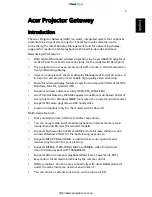
Page 30 / 141
DTUS065 rev A.7 – June 27, 2014
V.3
802.11 modes
There are 4 kinds of wireless transmission formats available: 802.11b,
802.11g, 802.11a and 802.11n.
V.3.1
802.11b
802.11b is supported for compatibility with old devices. Using it will lower
the throughput for all devices in the radio range, because 802.11b uses a lot
of bandwidth for little throughput.
Op. Frequency
Typical throughput
Bit Rate (Max)
2.4 GHz
4.5 Mbit/s
11 Mbit/s
Note
: actual throughput and bitrate depends on the distance between
stations, antennas quality and radio conditions
802.11b has a maximum raw data rate of 11 Mbit/s and uses the same media
access method defined in the original standard. 802.11b devices suffer
interference from other products operating in the 2.4 GHz band. Devices
operating in the 2.4 GHz range include: microwave ovens, Bluetooth
devices, baby monitors and old cordless telephones.
V.3.2
802.11g
This transmission standard works in the 2.4 GHz band (like 802.11b) but
operates at a maximum raw data rate of 54 Mbit/s, or about 20 Mbit/s mean
throughput. 802.11g hardware is fully backward compatible with 802.11b
hardware.
Op. Frequency
Typical throughput
Bit Rate (Max)
2.4 GHz
20 Mbit/s
54 Mbit/s
Note
: actual throughput and bitrate depends on the distance between
stations, antennas quality and radio conditions
Like 802.11b, 802.11g devices suffer interference from other products
operating in the 2.4 GHz band. Devices operating in the 2.4 GHz range
include: microwave ovens, Bluetooth devices, baby monitors and old
cordless telephones.
V.3.3
802.11a
The 802.11na operates in 5 GHz band with a maximum raw data rate of 54
Mbit/s, which yields a realistic mean throughput in the mid-20 Mbit/s.
Op. Frequency
Typical throughput
Bit Rate (Max)
5 GHz
20Mbit/s
54Mbit/s
Note
: actual throughput and bitrate depends on the distance between
stations, antennas quality and radio conditions
















































